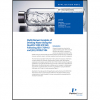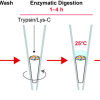Thermo Fisher Scientific has announced a co-marketing agreement with Biognosys AG to provide a comprehensive, efficient workflow to enable library creation and data processing for Data-Independent Acquisition (DIA) studies, through the combined use of Orbitrap mass spectrometers and Spectronaut Pulsar software. Compatible with the new Thermo Scientific Q Exactive HF-X Hybrid Quadrupole Orbitrap mass spectrometer, in addition to previous Orbitrap instruments, the Biognosys Spectronaut Pulsar software allows researchers to conduct data-independent analysis using MS1 quantitation for reproducible and accurate quantitation of thousands of proteins in a single run. DIA is a global method for the comprehensive recording of spectral signatures from all components of a sample, and can be used in combination with the latest high-resolution Orbitrap instruments as a universal method for global expression profiling.
Thermo Fisher Scientific and Biognosys announce co-marketing agreement
Rate this Article
Supplier
Rate this Article
Technique




![Targeted proton transfer charge reduction (tPTCR) nano-DESI mass spectrometry imaging of liver tissue from orally dosed rat (Animal 3). a) optical image of a blood vessel within liver tissue. b) Composite ion image of charge-reduced haeme-bound α-globin (7+ and 6+ charge states; m/z 2259.9 and m/z 2636.3 respectively, red) and the charged-reduced [FABP+bezafibrate] complex (7+ and 6+ charge states; m/z 2097.5 and m/z 2446.9 respectively, blue). c) Ion image composed from charge-reduced haeme-bound α-globin (7+ and 6+ charge states) showing abundance in blood vessels. d) Ion image composed from charge-reduced [FABP+bezafibrate] complex (7+ and 6+ charge states) showing abundance in bulk tissue and absence in the blood vessel. Reproduced from https://doi.org/10.1002/ange.202202075 under a CC BY licence. Light and mass spectromert imaging of tissue samples](/sites/default/files/styles/thumbnail/public/news/MSI%20drug-protein%20complex-w.jpg?itok=CBNIjyYl)




